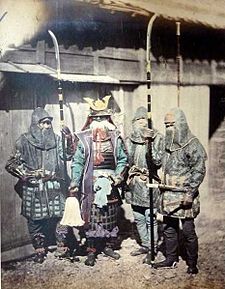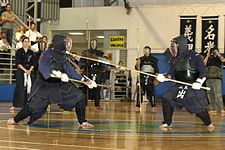- Naginata
-
The naginata (なぎなた, 薙刀) is one of several varieties of traditionally made Japanese blades (nihonto) in the form of a pole weapon. Naginata were originally used by the samurai class in feudal Japan, and naginata were also used by ashigaru (foot soldiers) and sōhei (warrior monks).[1]
Contents
Description
A naginata consists of a wooden shaft with a curved blade on the end; it is similar to the Chinese Guan Dao or European glaive. Usually it also had a sword-like hand guard (tsuba) between the blade and shaft. The 30 cm to 60 cm long naginata blade is forged in the same manner as traditional Japanese swords. The blade has a long tang (nakago) which is inserted in the shaft (nagaye or ebu), the blade is removable and is secured by means of a wood peg (mekugi) that passes though a hole (mekugi-ana) in both the nakago and the nagaye (ebu). The nagaye (ebu) ranges from 120 cm to 240 cm in length and is oval shaped. The area of the nagaye (ebu) were the naginata nakago sits is the tachiuchi or tachiuke. The tachiuchi (tachiuke) would be re-enforced with metal rings (naginata dogane or semegane), and or metal sleeves (sakawa) and wrapped with cord (san-dan maki), the end of the nagaye (ebu) had a heavy metal end cap (ishizuki or hirumaki). When not in use the naginata blade would be covered with a wooden sheath (saya).[1]
History
The naginata may have descended from the earlier hoko, possibly influenced by the Chinese Guan Dao.[2][3] It's difficult to tell when the naginata itself first appeared. Though often claimed as being invented by the sōhei during the Nara period, physical evidence of their existence dates only from the mid-Kamakura period, and earlier literary sources are ambiguous. The earliest clear references to naginata date from 1146 in the late Heian period, with one suggesting that the weapon may have been recent.[4] Earlier 10th through 12th century sources refer to "long swords" that while a common medieval term or orthography for naginata, could also simply be referring to conventional swords; one source describes a naginata being drawn with the verb nuku, commonly associated with swords, rather than hazusu, the verb otherwise used in medieval texts for unsheathing naginata. However, some 11th and 12th century mentions of hoko may actually have been referring to naginata.[5] The commonly-assumed association of the naginata and the sōhei is also unclear. Artwork from the late-13th and 14th centuries depict the sōhei with naginata but don't appear to place any special significance to it: the weapons appear as just part of a number of others carried by the monks, and are used by samurai and commoners as well.[6] Depictions of naginata-armed sōhei in earlier periods were created centuries after the fact, and are likely using the naginata as a symbol to distinguish the sōhei from other warriors, rather than giving an accurate portrayal of the events.[7]
During the Gempei War (1180–1185), in which the Taira clan was pitted against Minamoto no Yoritomo of the Minamoto clan, the naginata rose to a position of particularly high esteem, being regarded as an extremely effective weapon by warriors.[8] Cavalry battles had become more important by this time, and the naginata proved excellent at dismounting cavalry and disabling riders. The widespread adoption of the naginata as a battlefield weapon forced the introduction of sune-ate (shin guards) as a part of Japanese armor. The rise of importance for the naginata can be seen as being mirrored by the European pike, another long pole weapon employed against cavalry. The introduction in 1543 of firearms in the form of the matchlock (tanegashima) caused a great decrease in the appearance of the naginata on the battlefield. As battlefield tactics changed, the yari (spear) took the place of the naginata as the pole weapon of choice.
During the Edo Period, as the naginata became less useful for men on the battlefield, it became a symbol of the social status of women of the samurai class.[9] A functional naginata was often a traditional part of a samurai daughter's dowry. Although they did not typically fight as normal soldiers, women of the samurai class were expected to be capable of defending their homes while their husbands were away at war. The naginata was considered one of the weapons most suitable for women, since it allows a woman to keep opponents at a distance, where any advantages in height, weight, and upper body strength would be lessened. An excellent example of the role of women in Japanese society and martial culture is Itagaki, who, famous for her naginata skills, led the garrison of 3,000 warriors stationed at Toeizakayama castle. Ten thousand Hōjō clan warriors were dispatched to take the castle, and Itagaki led her troops out of the castle, killing a significant number of the attackers before being overpowered. The naginata saw its final uses in combat in 1868, at Aizu, and in 1876, in Satsuma.
Due to the influence of Westernization, after the Meiji Restoration the perceived value of martial arts, the naginata included, dropped severely. It was from this time that the focus of training became the strengthening of the will and the forging of the mind and body. During the Showa period, naginata training became a part of the public school system in 1912; and it "remains a staple of girls’ physical education"[10]
Martial arts training in Japan was banned for five years by the Allied Forces after Japan's surrender at the end of World War II. After the lifting of the ban in 1950, a modern form of naginata training, known as Atarashii naginata ("new naginata"), was developed. Since World War II, naginata has primarily been practiced as a sport with a particular emphasis on etiquette and discipline, rather than as military training.
Although associated with considerably smaller numbers of practitioners, a number of "koryu bujutsu" systems (old school martial arts) which include older and more combative forms of naginatajutsu remain existent, including Araki Ryu, Tendo Ryu, Jikishinkage ryu, Higo Koryu, Tenshin Shoden Katori Shinto Ryu,Toda-ha Buko Ryu and Yoshin ryu, some of which have authorized representatives outside Japan.
In the USA, there are an estimated 200 practitioners, half of whom are male.[11]
Modern naginata Construction
The modern naginata is between 210 cm and 225 cm in length and must weigh over 650 grams.[12] In contemporary naginatajutsu, there are two general constructions. The first, the kihon yo, is carved from one piece of Japanese white oak and is used for the practice of katas (forms). This is quite light, and may or may not feature the tsuba between the blade and shaft sections. The second type, the shiai yo, uses a similar wooden shaft, but the blade is constructed from bamboo and is replaceable as it can break through hard contact. This type is used in atarashii naginata, the bamboo blade being more forgiving on the target than a wooden or metal blade.
Many of the imitation "naginata" for sale to the public are not actually naginata at all, as may be concluded from the above details on proper construction. Specifically, these imitations have shorter, rounded shafts, very short blades, and screw-together sections.
Usage
Naginata can be used to batter, stab or hook an opponent',[10] but due to their relatively balanced center of mass, are often spun and turned to proscribe a large radius of reach. The curved blade makes for an effective tool for cutting due to the increased length of cutting surface. In the hands of a skilled practitioner, one 5-foot (1.5 m) tall wielder could conceivably cover and attack in 484 square feet (45 square meters) of open, level ground with a 5 foot (1.5 m) shaft, 3 foot (0.9 m) blade, 3 foot (0.9 m) reach.
Naginatas were often used by foot soldiers to create space on the battlefield. They have several situational advantages over a sword. Their reach was longer, allowing the wielder to keep out of reach of his opponent. The long shaft offered it more leverage in comparison to the hilt of the katana, enabling the naginata to cut more efficiently. The weight of the weapon gave power to strikes and cuts, even though the weight of the weapon is usually thought of as a disadvantage. The weight at the end of the shaft and the shaft itself can be used both offensively and defensively. Swords, on the other hand, can be used to attack faster, have longer cutting edges (and therefore more striking surface and less area to grab), and were able to be more precisely controlled in the hands of an experienced swordsman.
The martial art of wielding the naginata is known as naginatajutsu. Most naginata practice today is in a modernised form, a gendai budō called atarashii Naginata meaning "new Naginata",[1] in which competitions are held. Use of the naginata is also taught within the Bujinkan and in some koryū schools. Naginata practitioners may wear a form of the protective armour known as bōgu similar to that worn by kendō practitioners. Wearing the bogu means using a naginata that is a mix of light oak wood shaft, with a bamboo blade habu for atarashii Naginata.
The naginata has become associated in modern Japan as a woman's weapon as it is studied by women more than men, whereas in Europe and Australia naginata is practiced predominantly by men—this is however simply a reflection of the martial arts demographics of Europe, where there is no historical association—as there is in Japan—that naginatajutsu is for women.
Notable users
See also
Gallery
References
- ^ a b c Martial Arts of the World: An Encyclopedia of History and Innovation, Thomas A. Green, Joseph R. Svinth, ABC-CLIO, 2010 P.158
- ^ Draeger, David E. (1981). Comprehensive Asian Fighting Arts. Kodansha International. pp. 208. ISBN 978-0870114366.
- ^ Ratti, Oscar; Adele Westbrook (1999). Secrets of the Samurai: The Martial Arts of Feudal Japan. Castle Books. p. 241. ISBN 0-7858-1073-0.
- ^ Friday, Karl F. (2004). Samurai, Warfare and the State in Early Medieval Japan. Routledge. p. 86. ISBN 0-203-39216-7.
- ^ Friday (2004), page 87
- ^ Adolphson, Mikael S. (2007). The Teeth and Claws of the Buddha: Monastic Warriors and Sōhei in Japanese History. University of Hawai'i Press. pp. 130–133. ISBN 978-0-8248-3123-3.
- ^ Adolphson (2007), pp. 137, 140
- ^ Ratti, Oscar; Adele Westbrook (1991). Secrets of the Samurai: The Martial Arts of Feudal Japan. Tuttle Publishing. pp. 484. ISBN 978-0804816847.
- ^ Jones, Donn F.. Women Warriors: a History. Potomac Books. pp. 280. ISBN 978-1574882063.
- ^ a b Katz 2009
- ^ Katz, Mandy (2009). "Choose Your Weapon: Exotic Martial Arts". New York Times. http://www.nytimes.com/2009/04/16/fashion/16physicalculture.html?pagewanted=2&_r=1. Retrieved November 12, 2009.
- ^ Martial Arts of the World: An Encyclopedia of History and Innovation, Thomas A. Green, Joseph R. Svinth, ABC-CLIO, 2010 P.161
External links
- All Japan Naginata Federation
- US Naginata Federation home page and general information
- British Naginata Association
- Australian Naginata Federation
- Southern California Naginata Federation - history of the naginata
- Canadian Naginata Federation home page
- (Portuguese) Brazilian Naginata Association
- (French) Naginata webpage -(France)
- (French)(Portuguese)(English)(Dutch) Naginata.be -(Belgium)
- A list of traditional Naginatajutsu Ryu at Koryu.com
Construction Smithing · Polishing · MountingsSwords & daggers Shinken · Tsurugi · Chokutō · Katana · Tachi (Nodachi · Ōdachi · Zanbatō · Kodachi ) · Uchigatana · Shin guntō · Tantō · Wakizashi · Ninjatō · Yoroi tōshiPolearms Practice weapons Glossary · Category · National Treasure swordsCategories:- Japanese women in warfare
- Naginata
- Pole weapons
- Sport in Japan
- Weapons of Japan
- Blade weapons
- Samurai weapons and equipment
Wikimedia Foundation. 2010.






